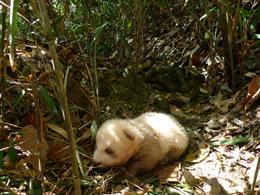Pandas are increasingly endangered in the wild, and the sighting of one with extremely rare brown-and-white fur is now raising fears that the species may be suffering from inbreeding.
In November 2009, a staff member at the Foping Nature Reserve in China's Qinling Mountains — one of the panda's last remaining strongholds — spotted a panda with the unusual colouring. It was estimated to weigh around 2 kilograms, which would suggest it was less than 2 months old at the time.
This is only the seventh such animal spotted in the region over the past 25 years, says Tiejun Wang, a spatial ecologist in the Department of Natural Resources at the University of Twente in Enschede, the Netherlands, who has worked in Foping for two decades. But the explanation for this unusual variety remains a mystery. "It's time we had a debate about what is causing this because it could be telling us something very important," he says.
Wang and his Twente colleague Andrew Skidmore are concerned that the brown-and-white form indicates that breeding between closely related pandas is becoming more common.
Each panda has two versions, or alleles, of each of its genes, one inherited from its mother and one from its father. Wang suggests that the Qinling pandas carry a dominant gene for black fur and a recessive gene for brown fur. This means that pandas with brown-and-white fur are only possible when they inherit the recessive brown gene from both mother and father.
The chances that both parents have the brown allele are ordinarily very low, suggests Wang. But the coincidence would be much more likely if the pandas were closely related. "The habitat in the Qinling Mountains is seriously fragmented and the population density is very high," says Wang. "The brown pandas could be an indication of local inbreeding."
Conservationists worry about such inbreeding because it means that more animals rely on the same set of genetic defences to overcome environmental threats, increasing their risk of extinction.
Genetic analysis
According to Wang, brown-and-white pandas have only been seen in the Qinling population, one of five mountain regions where pandas still live in the wild. Qinling is home to around 300 animals, roughly one-sixth of the total panda population in the wild.
The first recorded brown-and-white panda — a female called Dan-Dan — was discovered in 1985. She was taken into captivity, mated with a black-and-white animal and gave birth to a normal black-and-white male. A few years later, another brown-and-white panda was seen in the wild, together with its black-and-white mother. "These anecdotal observations strongly suggest the presence of a recessive gene or genes," says Wang.
The idea is worth investigating, says Sheng-guo Fang, a researcher at Zhejiang University in Hangzhou, China, who has studied the morphology and genetics of the Qinling pandas. But there could be other factors at play, he cautions.
Fang and colleagues have found that, although most of the Qinling pandas appear to be normal black-and-white animals, many of the region's pandas do have touches of brown in their chest fur1. This suggests that there could be something specific to Qinling, such as the climate or a particular environmental chemical, that affects one or more pigmentation genes, says Fang. "The Qinling Mountains have shaped brown subspecies of other mammals, such as the golden takin," he notes.
The idea of inbreeding in Qinling is also at odds with the most recent genetic analyses, which show that despite a dramatic contraction of the panda's range over the past few thousand years, the remaining giant panda populations seem to have retained a lot of genetic diversity2. "The evidence that giant pandas in general, and in the Qinling Mountains in particular, are of low genetic variation is at best equivocal," says Mike Bruford, a molecular ecologist at Cardiff University, UK, who worked on that study2.
The giant panda genome, which was published online in Nature last month3, also revealed little sign of inbreeding, says Jun Wang of the Beijing Genomics Institute in Shenzhen, China. But the genome is likely to prove invaluable for solving the mystery of the brown pandas of Qinling. "There are over 125 genes known to affect pigmentation in mice," says Hopi Hoekstra, an evolutionary biologist at Harvard University in Cambridge, Massachusetts, and an expert on pigmentation in mammals. "There are definitely a good handful of candidate genes you could sequence in the two morphs and look for differences," she says.
Jun Wang and his colleagues are already on the case. So far, they have studied the sequence of some 50 genes known to be involved in pigmentation. A comparison of brown and black pandas at Qinling and other sites should shed light on the genetic basis of this rare variety, he says.
References
- Wan, Q.-H., Wu, H. & Fang, S.-G. J. Mammal. 86, 397-402 (2005). | Article
- Zhang, B. et al. Mol. Biol. Evol. 24, 1801-1810 (2007). | Article | ChemPort |
- Li, R. et al. Nature advance online publication doi:10.1038/nature08696 (2009).
